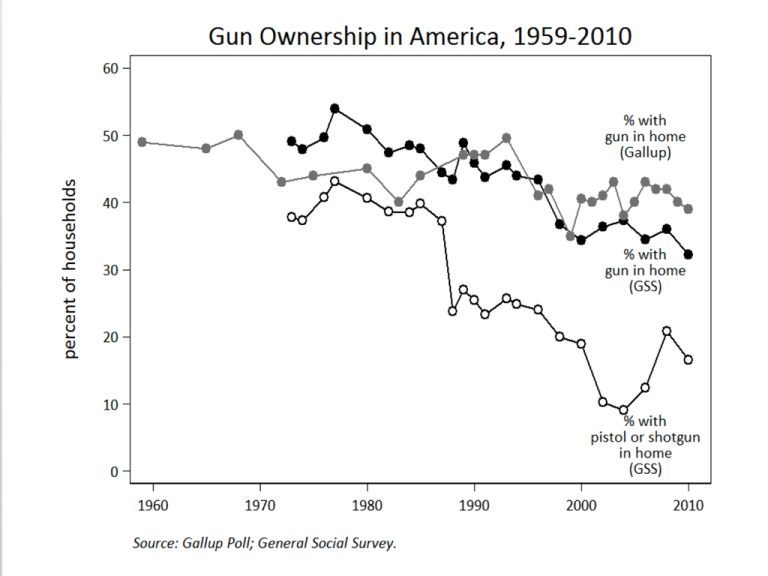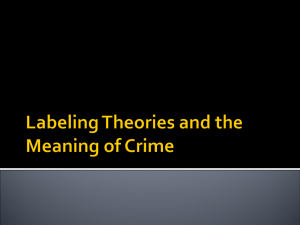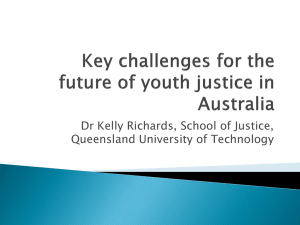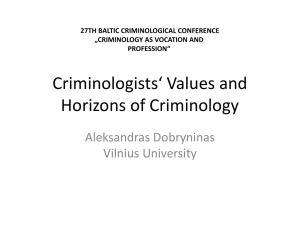
Measuring &
Explaining Crime
Mr. Concannon Smith
Uniform Crime Report (UCR)
Each year, statisticians from the U.S.
Department of Justice release the Unified
Crime Report (UCR).
First report issued in 1930
Attempts to measure the overall rate of
crime by organizing offenses known to the
police
This report relies on the voluntary
participation of local law enforcement
agencies (think Holden PD)
The Data
The data are based on these three
measurements:
1. The number of persons arrested for said
crime
2. The number of crimes reported by victims,
witnesses and police
3. The number of officers and support law
enforcement officials
FBI Number Crunchers
Once the data are collected the FBI presents it in
two ways:
1. As a rate per 100,000 people per year.
For example: In 2011, the rate of property crime
was estimated at 2,908 per 100,000 inhabitants
(for the year)
2. As a percentage change from the previous year or
other time periods
Example: between 2008 and 2009 violent crimes
decreased by 6.1 percent.
Part I Offenses
Most measured crimes
Murder
Forcible Rape
Robbery
Aggravated assault
Burglary- B&E
Larceny/Theft
Motor Vehicle Theft
Arson
Politicized Stats: Game of Lies
Explaining
Crime Trends
Or desperately trying to…
Mr. Concannon Smith
Do Now
What is a trend (statistically speaking)?
What are some common trends we hear
about related to crime?
Are they myth or fact?
Crime in Decline
Between 1900-2000 the homicide rate in the U.S.
dropped by 39%
Robberies dropped by 44%
Burglary dropped by 41%
Auto theft by 37%
What was responsible?
According to criminologists, many things
contributed to this “golden era” of declining
crime rates
Reasons Provided for Recent Drop in Crime:
The economy was robust.
Police tactics (to be discussed later) became more
efficient during this time period
Incarcerations were high due to passage of many
zero tolerance laws on lesser crimes
Sadly, many involved in the crack-cocaine boom of
the 1980s are dead (killed or otherwise), some are
in prison, or no longer offending (as is often the
case with rehabilitated drug offenders)
Legalized Abortion?
Recent economic downturn helps this theory…
Difficulty in Explaining Crime
The Crack Epidemic and the War of Drugs
Race and Crime
The Crack/ Powder
Cocaine Disparity
Problem
Criminology in
Action
Mr. Concannon Smith
Criminology
Criminology: the scientific study of crime and
the causes of criminal behavior
Criminologist: a specialist in the field of crime,
the causes of crime, and certain criminal
behaviors
We must be very careful when we start talking
about causation.
Correlation is NOT Causation
Criminologists use correlative data to form
theories
Important Distinction
Theory
Explanation of a
happening or
circumstance
based on
observation,
experimentation,
or reasoning
Hypothesis
A possible
explanation for
an observed
occurrence that
can be tested by
further
investigation
Theories about Crime
Choice Theories (Classical)
A person commits a
crime because the choose
to do so
Before committing the
crime he/she weighs the
benefits against the costs
End result of a series of
rational choices
Leads to deterrence
policies
Trait Theories
Biological or Psych traits
incline them towards
criminal activity
Hormonal responsibility
Criminal activity in males
has been linked to high
levels of testosterone
(which controls
secondary sex
characteristics and
triggers aggression)
Theories about Crime
Sociological Theories
A person commits a
crime because the choose
to do so
Before committing the
crime he/she weighs the
benefits against the costs
End result of a series of
rational choices
Leads to deterrence
policies
Interactionist Theories
Biological or Psych traits
incline them towards
criminal activity
Hormonal responsibility
Criminal activity in males
has been linked to high
levels of testosterone
(which controls
secondary sex
characteristics and
triggers aggression)
Tomorrow: The Brain and Crime
Do Now
Why would someone who subscribes to
Choice Theory believe that increasing the
harshness of a penalty for a crime
would likely lead to a reduction in that
crime?
Why would a Trait Theorist disagree?
The Brain & Crime
Mr. Concannon Smith
The Brain and Crime: Psych 101
The study of brain activity––neurophysiology––is
a growing field in criminology.
Neurophysiology explained:
Cells in the brain known as neurons communicate
with each other by releasing chemicals called
neurotransmitters
NPY Criminologists have isolated three that are
related to aggressive behavior
1. Serotonin
2. Norepinephrine
3. Dopamine
Serotonin: chemical that regulates moods, appetite, and
memory
Antidepressant medication changes these levels
Norepinephrine: regulates sleep-wake cycles and controls how
we respond to anxiety fear, and stress
Prescription sleep medication and general anxiety medication
alter these levels
Dopamine: regulates perceptions of pleasure and reward.
Levels altered by many things from simply eating to doing drugs
(heroin is a good example)
Research has shown that low levels of serotonin and high levels
of norepinephrine are correlated with aggressive behavior.
Research shows strong
connection between
violent behavior and
damage to the frontal
lobe
Among other things,
the frontal lobe
regulates out ability to
behave properly in
social situations
Tend to act more
impulsively and
violently (not generally
but in reactive
situations)
Do Now
How many of you have seen a
really drunk person?
How did they act?
Were they in a group setting?
Drugs & Crime
Mr. Concannon Smith
Drugs and Crime
Criminologists (Penn State) believe that alcohol
consumption has a causal effect on victimization
“frequent and heavy drinkers” are at great risk
of being assaulted when they are drinking
(no abnormal signs show while sober)
They hypothesize that consuming alcohol leads
to aggressive and offensive behavior (especially
in men) which in turn triggers violent reactions
from others.
Drug use in America
Today, about 20,000,000 Americans regularly use
illegal drugs such as marijuana and cocaine (6.5%)
Another 200,000,000 regularly use legal drugs like
alcohol and nicotine
Criminologist Explanations of
Drug Use
Why use drugs?
At first glance: because drugs give pleasure and provide a
temporary escape for those with tension and anxiety
This fails to explain why some people use and others do not.
Social Disorganization Theory: rapid social change can cause
disaffiliation with society causing antisocial drug use
Learning Theory: sees drug use as a learned behavior (habitual)
1.
Learn the techniques
2.
Learn to perceive pleasure
3.
Learn to enjoy the social experience
Use vs. Abuse
Drug Abuse: use that results in physical or
psychological harm for the user or a third party.
For most drugs only between 7 and 20 percent of
all users suffer from compulsive abuse.
Addiction: the most extreme abusers are often
physically dependent on a drug.
To understand addiction, you must understand the role of
dopamine in the brain.
So much dopamine is triggered that the receptors are worn out
over time so more dopamine is needed to obtain the same
levels of pleasure
Drug Crime Relationship
More than 2/3 of jail inmates are either dependent on or
abuse drugs
More then 1/3 were under the influence at time of offense
Drug use and our laws have been a primary factor in the
enormous growth of the American correctional industry
Three models:
1. Psychopharmacological model: drugs made me do it
2. Economically impulsive: need drug money
3. Systemic model: by product of the interpersonal
relationships in the drug subculture
Broken Window Theory
Mr. Concannon Smith
Criminology from Theory to Practice
Criminology can play a crucial role in the criminal justice
system
Research has established the idea of the chronic offender
or career criminal
A small group of offenders (6 %) are responsible for a
disproportionate number of violent crimes
Further research has supported this claim
Has allowed law enforcement agencies and district
attorneys’ offices to devise specific strategies to apprehend
and prosecute repeat offenders
Broken Windows Theory
The broken windows theory is the norm-setting and signaling
effect of urban disorder and vandalism on additional crime.
How it works:
1.
In an urban environment, with few or no other people around,
social norms and monitoring are not clearly known.
2.
Individuals look for signals within the environment as indicators
of social norms in the setting (assess risk for violating those
norms; one of those signals is the area's general appearance)
3.
An ordered and clean environment sends the signal that the area is
monitored and that criminal behavior will not be tolerated.
4.
Conversely, a disordered environment – one which is not
maintained (broken windows, graffiti, excessive litter) – sends the
signal that the area is not monitored and that one can engage in
criminal behavior with little risk of detection.
Criminology and the
Criminal Justice System
Some critics contend that criminology has not
done enough to make society safer
But many theories (e.g., broken windows
theory) have helped to re-shape criminal
justice strategies
Criminological theories have a part to play in
helping the criminal justice system break the
cycle of criminal activity
The Alcohol Tobacco &
Firearms and Explosives
Visit Introduction
Department of Justice
Mr. Concannon Smith
The ATF
Concerned with the illegal sale, possession, and
use of firearms and the control of untaxed
tobacco and liquor products
Includes modified and illicit weapons production
Regulates all gun trade between the United States
and foreign nations and collects taxes on all
firearm importers, manufacturers, and dealers
Responsible for policing the illegal use and
possession of explosives (and Arson cases)
Charged with enforcing federal gambling laws











